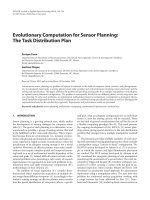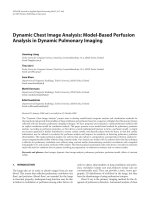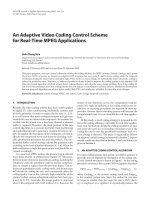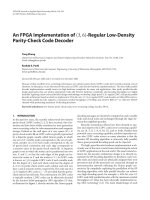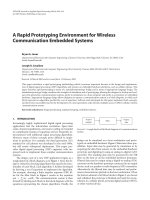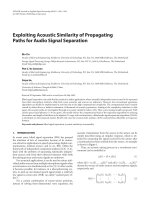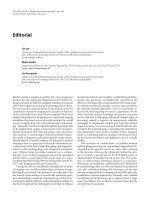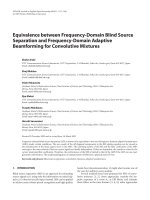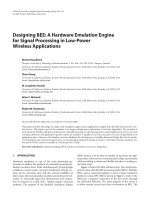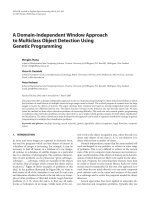EURASIP Journal on Applied Signal Processing 2003:8, 806–813 c 2003 Hindawi Publishing pot
Bạn đang xem bản rút gọn của tài liệu. Xem và tải ngay bản đầy đủ của tài liệu tại đây (754.63 KB, 8 trang )
EURASIP Journal on Applied Signal Processing 2003:8, 806–813
c
2003 Hindawi Publishing Corporation
Optimization and Assessment of Wavelet Packet
Decompositions with Evolutionary Computation
Thomas Schell
Department of Scientific Computing, University of Salzburg, Jakob Haringer Street 2, A-5020 Salzburg, Austria
Email: ts
Andreas Uhl
Department of Scientific Computing, University of Salzburg, Jakob Haringer Street 2, A-5020 Salzburg, Austria
Email:
Received 30 June 2002 and in revised form 27 November 2002
In image compression, the wavelet transformation is a state-of-the-art component. Recently, wavelet packet decomposition has
received quite an interest. A popular approach for wavelet packet decomposition is the near-best-basis algorithm using nonadditive
cost functions. In contrast to additive cost functions, the wavelet packet decomposition of the near-best-basis algorithm is only
suboptimal. We apply methods from the field of evolutionary computation (EC) to test the quality of the near-best-basis results.
We observe a phenomenon: the results of the near-best-basis algorithm are inferior in terms of cost-function optimization but are
superior in terms of rate/distortion performance compared to EC methods.
Keywords and phrases: image compression, wavelet packets, best basis algorithm, genetic algorithms, random search.
1. INTRODUCTION
The DCT-based schemes for still-image compression (e.g.,
the JPEG standard [1]) have been superceded in favor
of wavelet-based schemes in the last years. Consequently,
the new JPEG2000 standard [2] is based on the wavelet
transformation. Apart from the pyramidal decomposition,
JPEG2000 part II also allows wavelet packet ( WP) decom-
position which is of particular interest to our studies.
WP-based image compression methods which have been
developed [3, 4, 5, 6] outperform the most advanced wavelet
coders (e.g., SPIHT [7]) significantly for textured images i n
terms of rate/distortion performance (r/d).
In the context of image compression, a more advanced
but also more costly technique is to use a framework that
includes both rate and distortion, where the best-basis (BB)
subtree which minimizes the global distortion for a given
coding budget is searched [8, 9]. Other methods use fixed
bases of subbands for similar signals (e.g., fingerprints [10])
or search for good representations with general purpose op-
timization methods [11, 12].
Usually in wavelet-based image compression, only the
coarse scale approximation subband is successively decom-
posed. With the WP decomposition also, the detail subbands
lend themselves to further decomposition. From a prac tical
point of view, each decomposed subband results in four new
subbands: approximation, horizontal detail, ver tical detail,
and diagonal detail. Each of these four subbands can be re-
cursively decomposed at will. Consequently, the decomposi-
tion can be represented by a quadtree.
Concerning WPs, a key issue is the choice of the decom-
position quadtree. Obviously, not every subband must be de-
composed further; therefore, a criterion which determines
whether a decomposition step should take place or not is
needed.
Coifman and Wickerhauser [13] introduced additive cost
functions and the BB algorithm wh ich provides an op-
timal decomposition according to a specific cost met ric.
Taswell [14] introduced nonadditive cost functions which are
thought to anticipate the properties of “good” decomposi-
tion quadtrees more accurately. With nonadditive cost func-
tions, the BB algorithm mutates to a near-best-basis (NBB)
algorithm because the decomposition trees are only subop-
timal. The div ide-and-conquer principle of the BB relies on
the locality (additivity) of the underlying cost function. In
the case of nonadditive cost functions, this locality does not
exist.
In this work, we are interested in the assessment of
the WP decompositions provided by the NBB algorithm.
We focus on the quality of the NBB results in terms of
Optimization and Assessment of Wavelet Packet Decompositions with Evolutionary Computation 807
cost-function optimization as well as image quality (PSNR).
Both, the cost-function value and the corresponding image
quality of a WP decomposition is suboptimal due to the con-
struction of the NBB algorithm.
We have interfaced the optimization process of WP de-
compositions by means of cost functions with the concepts
of evolutionary computation (EC). Hereby, we obtain an al-
ternative method to optimize WP decompositions by means
of cost functions. Both approaches, NBB and EC, are subject
to our experiments. The results provide valuable new insights
concerning the intrinsic processes of the NBB algorithm. Our
EC approach perfectly suits the needs for the assessment of
the NBB algorithm but, from a practical point of view, the
EC approach is not competitive in terms of computational
complexity.
In Section 2, we review the definition of the cost func-
tions which we analyze in our experiments. The NBB al-
gorithm is described in Section 3. For the EC methods, we
need a “flat” representation of quadtrees (Section 4). In Sec-
tions 5 and 6, we review genetic algorithms and random
search specifically adapted to WP optimization. For our ex-
periments, we apply an SPIHT inspired software package for
image compression by means of WP decomposition. Our
central tool of analysis are scatter plots of WP decomposi-
tions (Section 7). In Section 8, we compare the NBB algo-
rithm and EC for optimizing WP decompositions.
2. COST FUNCTIONS
As a preliminary, we review the definitions of a cost func-
tion and the additivity. A cost function is a func tion C :
R
M
× R
N
→ R.Ify ∈ R
M
× R
N
is a matrix of wavelet
coefficients and C is a cost function, then C(0) = 0and
C(y) =
i,j
C(y
ij
). A cost function C is additive if and only
if
C
a
z
1
⊕ z
2
= C
a
z
1
+ C
a
z
2
, (1)
where z
1
, z
2
∈ R
M
× R
N
are matrices of wavelet coefficients.
The goal of any optimization algorithm is to identify a WP
decomposition with a minimal cost-function value.
Alternatively to the NBB algorithm (Section 3), we apply
methods from evolutionary computation (Sections 5 and 6)
to optimize WP decompositions. The fitness of a particular
WP decomposition is estimated with nonadditive cost func-
tions. We employ the three nonadditive cost functions listed
below.
(i) Coifman Wickerhauser entropy. Coifman and Wicker -
hauser [15] defined the entropy for wavelet coefficients as fol-
lows:
C
1
n
(y) =
i,j:p
ij
=0
p
ij
ln p
ij
,p
ij
=
y
ij
2
y
2
. (2)
(ii) Weak l
p
Norm. For the weak l
p
norm [16], we need to
reorder and transform the coefficients y
ij
.Allcoefficients y
ij
are rearranged in a decreasing absolute-value sorted vector z,
that is, z
1
=|y
i
1
j
1
|≥···≥z
MN
=|y
i
M
j
N
|. Hence, the size
of vector z is MN. The cost-function value is calculated as
follows:
C
4,p
n
(y) = max
k
k
1/p
z
k
. (3)
From the definition of the weak l
p
norm, we deduce that un-
favorable slowly decreasing sequences or, in the worst case,
uniform sequences of vectors z cause high numerical values
of the norm, whereas fast decreasing z’s result in low ones.
(iii) Shannon entropy. Below, we will consider the ma-
trix y simply as a collection of real-valued coefficients x
i
,
1 ≤ i ≤ MN.Thematrixy is rearranged such that the first
row is concatenated with the second row at the right side and
then the new row is concatenated with the third row and so
on. With a simple histogram binning method, we will esti-
mate the probability mass function. The sample data interval
is given by a = min
i
x
i
and b = max
i
x
i
. Given the number of
bins J, the bin width w is w = (b − a)/J. The frequency f
j
for
the jth bin is defined by f
j
= #{x
i
| x
i
≤ a + jw}−
j−1
k=1
f
k
.
The probabilities p
j
are calculated from the frequencies f
j
simply by p
j
= f
j
/MN. From the obtained class probabili-
ties, we can calculate the Shannon entropy [14]
C
2,J
n
(y) =−
J
j=1
p
j
log
2
p
j
. (4)
Cost functions are an indirect strategy to optimize the
image quality. PSNR can be seen as a nonadditive cost func-
tion. With a slightly modified NBB, PSNR as a cost function
provides WP decomposition with an excellent r/d perfor-
mance, but at the expense of high computational costs [12].
3. NBB ALGORITHM
With additive cost functions, a dynamic programming ap-
proach, that is, the BB algorithm [13], provides the optimal
WP decomposition with respect to the applied cost function.
Basically, the BB algorithm traverses the quadtree in a depth-
first-search manner and starts at the level right above the
leaves of the decomposition quadtree. The sum of the cost
of the children node is compared to the cost of the parent
node. If the sum is less than the cost of the parent node, the
situation remains unchanged. But, if the cost of the parent
node is less than the cost of the children, then the child nodes
are pruned off the tree. From b ottom upwards, the tree is re-
duced whenever the cost of a certain branch can be reduced.
An illustrating example is presented in [15]. It is an essential
property of the BB algorithm that the decomposition t ree is
optimal in terms of the cost criteria, but not in terms of the
obtained r/d performance.
When switching from additive to nonadditive cost func-
tions, the locality of the cost function evaluation is lost. The
BB algorithm can still be applied because the correlation
among the subbands is assumed to be minor but obviously
the result is only suboptimal. Hence, instead of BB, this new
variant is called NBB [14].
808 EURASIP Journal on Applied Signal Processing
4. ENCODING OF WP QUADTREES
To interface the WP software and the EC methods, we use
a flat representation of a WP-decomposition quadtree. In
other words, we want an encoding scheme for quadtrees in
the form of a (binary) string. Therefore, we have adopted
the idea of coding a heap in the heap-sort algorithm. We use
strings b of finite length L over a binary alphabet {0, 1}. If the
bit at index k,1≤ k ≤ L, is set, then the according subband
has to be decomposed. Otherwise, the decomposition stops
in this branch of the tree
b
k
=
1decompose,
0stop.
(5)
If the bit at index k is set (b
k
= 1), the indices of the resulting
four subbands are derived by
k
m
= 4 · k + m, 1 ≤ m ≤ 4. (6)
In heaps, the levels of the tree are implicit. We denote the
maximal level of the quadtree by l
max
∈ N. At this level, all
nodes are leaves of the quadtree. The level l of any node k in
the quadtree can be determined by
l =
0,k= 0(root),
l :
l−1
r=0
4
r
≤ k<
l
r=0
4
r
,k>0.
(7)
The range of level l is 0 ≤ l ≤ l
max
.
5. GENETIC ALGORITHM
Genetic algorithms (GAs) are evolution-based search algo-
rithms especially designed for parameter optimization prob-
lems with vast search spaces. GAs were first proposed in the
seventies by Holland [17]. Generally, parameter optimization
problems consist of an objective function to evaluate and es-
timate the quality of an admissible par ameter set, that is, a so-
lution of the problem (not necessarily the optimal, just any-
one). For the GA, the parameter set needs to be encoded into
a string over a finite alphabet (usually a binary alphabet). The
encoded parameter set is called a genotype. Usually, the ob-
jective function is slightly modified to meet the requirements
of the GA and hence w ill be called fitness function. The fit-
ness function determines the quality (fitness) for each geno-
type (encoded solution). The combination of a genotype and
the corresponding fitness forms an individual. At the start of
an evolution process, an initial population, which consists of
a fixed number of individuals, is generated randomly. In a
selection process, individuals of high fitness are selected for
recombination. The selection scheme mimics nature’s princi-
ple of the survival of the fittest. During recombination, two
individuals at the time exchange genetic material, that is,
parts of the genotype string, are exchanged at random. Af-
ter a new intermediate population has been created, a mu-
tation operator is applied. The mutation operator randomly
changes some of the alleles (values a t certain positions/loci of
the genotype) with a small probability in order to ensure that
alleles which might have vanished from the population have
a chance to reenter. After apply ing mutation, the intermedi-
ate population has turned into a new one (next generation)
replacing the former.
For our experiments, we apply a GA which starts with an
initial population of 100 individuals. The initial population is
generated randomly. The chromosomes are decoded into WP
decompositions as described in Section 4. The fitness of the
individuals is determined with a cost function (Section 2).
Then, the standard cycle of selection, crossover, and muta-
tion is repeated 100 times, that is, we evolve 100 generations
of the initial population. The maximum number of gener-
ations was selected empirically such that selection schemes
with a low selection pressure sufficiently converge. As selec-
tion methods, we use binary tournament select ion (TS) with
partial replacement [18] and linear ranking selec tion (LKR)
with η
= 0.9[19]. We have experimented with two variants
of crossover. Firstly, we applied standard two-point crossover
but obviously this type of crossover does not take into ac-
count the tree structure of the chromosomes. Additionally,
we have conducted experiments with a tree-crossover op-
erator (Section 5.1) which is specifically adapted to opera-
tions on quadtrees. For both, two-point crossover and tree
crossover, the crossover rate is set to 0.6 and the mutation
rate is set to 0.01 for all experiments.
As a by-product, we obtained the results presented in
Figure 1 for the image Barbara (Figure 5). Instead of a cost
function, we apply the image quality (PSNR) to determine
the fitness of an individual (i.e., WP decomposition). We
present the development of the PSNR during the course of a
GA. We show the GA results in the following parameter com-
binations: LRK and TS, each with either two-point crossover
or with tree crossover. After every 100th sample (population
size of the GA) of the random search (RS, Section 6), we
indicate the best-so-far WP decomposition. Obviously, for
each evaluation of a WP decomposition, a full compression
and decompression step w h ich causes a tremendous execu-
tion time is required. The result of a NBB optimization using
weak l
1
norm is displayed as a horizontal line because the
runtime of the NBB algorithm is far below the time which is
required to evolve one generation of the GA. The PSNR of
the NBB algorithm is out of reach for RS and GA. The tree-
crossover operator does not improve the performance of the
standard GA. The execution of a GA or RS run lasts from 6
to 10 days on an AMD Duron processor with 600 MHz. The
GA using TS with and without tree crossover was not able to
complete the 100 generations within this time limit. Further
examples of WP optimization by means of EC are discussed
in [20].
5.1. Tree crossover
Standard crossover operators (e.g., one-point or two-point
crossover) have a considerably disruptive effect on the tree
structure of subbands which is encoded into a binary string.
With the encoding discussed above, a one- or two-point
crossover results in two new individuals with tree structures
which are almost unrelated to the tree structures of their
Optimization and Assessment of Wavelet Packet Decompositions with Evolutionary Computation 809
25.5
25.4
25.3
25.2
25.1
25
24.9
24.8
24.7
PSNR
0 102030405060708090100
Generations
NBB: Wl
RS
GA:TS(t = 2)
GA: LRK (η = 0.9)
GA: TS (t = 2), tree crossover
GA: LRK (η = 0.9), tree crossover
Figure 1: Comparison of NBB, GA, and RS.
Table 1: Chromosomes of two individuals.
12345678910111213···
A 101001000 0 0 1 1 ···
B 110110011 1 1 0 0 ···
parents. This obviously contradicts the basic idea of a GA,
that is, the GA is expected to evolve better individuals from
good parents.
To demonstrate the effect of standard one-point
crossover, we present a simple example. The chromosomes
of the parent individuals A and B are listed in Ta ble 1 and
the according binary trees are shown in Figure 2.Asacut
point for the crossover, we choose the gap between gene 6
and 7. The chromosome parts from locus 7 to the right end
of the chromosome are exchanged between individuals A and
B. This results in two new trees (i.e., individual A
and B
)
which are displayed in Figure 3. Evidently, the new genera-
tion of trees differ considerably from their parents.
The notion is to introduce a problem-inspired crossover
such that the overall tree structure is preserved while only lo-
cal parts of the subband trees are altered [11]. Specifically,
one node in each individual (i.e., subband tree) is chosen at
random, then the according subt rees are exchanged between
the individuals. In our example, the candidate nodes for the
crossover are node 2 in individual A and node 10 in indi-
vidual B. The tree crossover produces a new pair of descen-
dants A
and B
which are displayed in Figure 4.Compared
to the standard crossover operator, tree crossover moderately
alters the structure of the parent individuals a nd generates
new ones.
6. RANDOM SEARCH
The random generation of WP decompositions is not
straightforward due to the quadtree st ructure. If we consider
1
2
3
45
6
7
8 9 10 11
12
13
14 15
(a) Individual A.
1
2
3
4567
8
9
10 11 12 13 14 15
(b) Individual B.
Figure 2: Parent individuals before crossover.
2
1
3
45
67
8 9 10 11
12
13
14 15
(a) Individual A
.
1
2
3
4567
89
10 11 12 13 14 15
(b) Individual B
.
Figure 3: Individuals after conventional one-point crossover.
a 0/1 string as an encoded quadtree (Section 4 ), we could
obtain random WP decomposition just by creating random
0/1 strings of a given length. An obvious drawback is that
this method acts in favor of small quadtrees. We assume that
810 EURASIP Journal on Applied Signal Processing
1
2
3
4
5
67
891011
12
13
14 15
(a) Individual A
.
1
23
4
567
8
910
11
12 13 14 15
(b) Individual B
.
Figure 4: Individuals after tree crossover.
the root node always exists and that it is on level l = 0.
This is a useful assumption because we need at least one
wavelet decomposition. The probability to obtain a node at
level l is (1/2)
l
. Due to the rapidly decreasing probabilities,
the quadt rees will be rather sparse.
Another admittedly theoretical approach would be to as-
sign a uniform probability to all possible quadtrees. Then,
this set is sampled for WP decompositions. Some simple con-
siderations will show that in this case small quadtrees are
excluded from evaluation. In the following, we will calcu-
late the number A(k) of trees with nodes on equal or less
than k levels. If k = 0, then we have A(0) := 1because
there is only the root node on level l = 0. For A(k), we
obtain the recursion A(k) = [1 + A(k − 1)]
4
because we
can construct quadtrees of height equal to or less than k by
adding a new root node to trees of height k − 1. The num-
ber of quadtrees B(k)ofheightk is given by B(0) := 1and
B(k) = A(k) − A(k − 1), k ≥ 1. From the latter argument, we
see that the number of quadtrees of height B(k) increases ex-
ponentially. Consequently, the number of trees of low height
is diminishing and hence, when uniformly sampling the set
of quadt rees, they are almost excluded from the evaluation.
With image compression in mind, we are interested in
trees of low height because trees with a low number of nodes
and a simple structure require less resources when encoded
into a bitstream. Therefore, we have adopted the RS approach
of the first paragraph with a minor modification. We require
that the approximation subband is at least decomposed down
to level 4 because it contains usually a considerable amount
of the overall signal energy.
Figure 5: Barbara.
Similar to the GA, we can apply the RS using PSNR in-
stead of cost functions to evaluate WP decompositions. Us-
ing a RS as discussed above with a decomposition depth of
at least 4 for the approximation subband, we generate 4000
almost unique samples of WP decompositions and evaluate
the corresponding PSNR. The WP decomposition with the
highest PSNR value is recorded. We have repeated the single
RS runs at least 90 times. The best three results in decreas-
ing order and the least result of a single RS run for the image
Barbaraarepresentedasfollows:24.648, 24.6418, 24.6368,
,24.4094.
If we compare the results of the RS to those obtained by
NBB with cost function weak l
1
norm (PSNR 25.47), we re-
alize that the RS is about 1 dB below the NBB algorithm. To
increase the probability of a high quality result of the RS, a
drastic increase of the sample size is required, which again
would result in a tremendous increase of the RS runtime.
7. CORRELATION OF COST FUNCTIONS
AND IMAGE QUALITY
Our experiments are based on a test library of images with
a broad spectrum of visual features. In this work, we present
the results for the well-known image Barbara. The consider-
able amount of texture in the test picture demonstrates the
superior performance of the WP approach in principle.
The output of the NBB, GA, and RS is a WP decompo-
sition. WPs are a generalization of the pyramidal decompo-
sition. Therefore, we apply an algorithm similar to SPIHT
which exploits the hierarchical structure of the wavelet co-
efficients [21] (SMAWZ). SMAWZ uses the foundations of
SPIHT, most importantly the zero-tree paradig m, and adapts
them to WPs.
Cost functions are the central design element in the NBB
algorithm. The working hypothesis of (additive and nonad-
ditive) cost functions is that a WP decomposition with an op-
timal cost-function value provides also a (sub-) optimal r/d
performance. The optimization of WP decompositions via
cost functions is an indirect strategy. Therefore, we compare
the results of the EC methods to that of the NBB algorithm
by generating scatter plots. In these plots, we simultaneously
Optimization and Assessment of Wavelet Packet Decompositions with Evolutionary Computation 811
26
25
24
23
22
21
20
19
18
17
16
15
PSNR
34567891011
Coifman-Wickerhauser entropy
Random WPs
Figure 6: Correlation between Coifman-Wickerhauser entropy and
PSNR.
provide for each WP decomposition the information about
the cost-function value and the image quality (PSNR).
Figure 6 displays the correlation of the nonadditive cost-
function Coifman-Wickerhauser entropy and the PSNR. For
the plot, we generated 1000 random WP decompositions and
calculated the value of the cost function and the PSNR after
a compression with 0.1 bpp. Note that WP decompositions
with the same decomposition level of the approximation sub-
band are grouped into clouds.
8. QUALITY OF THE NBB ALGORITHM WITH RESPECT
TO COST-FUNCTION OPTIMIZATION
The basic idea of our assessment of the NBB algorithm is to
use the GA to evolve WP decompositions by means of cost-
function optimization. Therefore, we choose some nonad-
ditive cost functions and compute WP decompositions with
the NBB algorithm, a GA, and a RS. For each cost function,
we obtain a collection of suboptimal WP decompositions.
We calculate the PSNR for each of the WP decompositions
and generate scatter plots (PSNR versus cost-function value).
The comparison of the NBB, GA, and RS results provide sur-
prising insight into the intrinsic processes of the NBB algo-
rithm.
We apply the GA and RS as discussed in Sections 5 and 6,
using the nonadditive cost-functions Coifman-Wickerhauser
entropy, weak l
1
norm, and Shannon entropy to optimize
WP decompositions. The GA as wel l as the RS generate and
evaluate 10
4
WP decompositions. The image Barbara is de-
composed according to the output of NBB, GA, and RS and
compressed to 0.1 bpp. Afterwards, we determine the PSNR
of the original and the decompressed image.
In Figure 7, we present the plot for the correlation be-
tween the Coifman-Wickerhauser entropy and PSNR for
NBB, GA, and RS. The WP decomposition obtained by the
NBB algorithm is displayed as a single dot. The other dots
25.4
25.2
25
24.8
24.6
24.4
24.2
PSNR
3.48 3.485 3.49 3.495 3.53.505 3.51 3.515 3.52 3.525 3.53
Coifman-Wickerhauser entropy
NBB
RS
GA:TS(t = 2)
GA: LRK (η = 0.9)
GA: TS (t = 2), tree crossover
GA: LRK (η = 0.9), tree crossover
Figure 7: Correlation between Coifman-Wickerhauser entropy and
PSNR for WP decompositions obtained by NBB, RS, and GA.
represent the best individual found either by a RS or a GA
run. With the Coifman-Wickerhauser entropy, we notice a
defect in the construction of the cost function. Even though
the GA and RS provide WP decompositions with a cost-
function value less than that of the NBB, the WP decompo-
sition of the NBB is superior in terms of image quality. As a
matter of fact, the NBB provides suboptimal WP decompo-
sitions with respect to the Coifman-Wickerhauser entropy.
The correlation between weak l
1
norm and PSNR is dis-
played in Figure 8. Similar to the scatter-plot of the Coifman-
Wickerhauser entropy, the WP decomposition of the NBB is
an isolated dot. But this time, the GA and the RS are not able
to provide a WP decomposition with a cost-function value
less than the cost-function value of the NBB-WP decompo-
sition.
Even more interesting is the cost-function Shannon en-
tropy (Figure 9). Similar to the Coifman-Wickerhauser en-
tropy, the Shannon entropy provides WP decompositions
with a cost-function value lower than the NBB. In the up-
per right of the figure, there is a singular result of the GA
using TS. This WP decomposition has an even higher cost-
function value than the one of the NBB but is superior in
terms of PSNR.
In general, the GA employing LRK provides better results
than the GA using TS concerning the cost-function values.
Within the GA-LRK results, there seems to be a slight advan-
tage for the tree crossover. In all three figures, the GA-LRK
with and without tree crossover is clearly ahead of the RS.
This is evidence for a more efficient optimization process of
the GA compared to RS.
In two cases (Figures 7 and 9), we observe the best cost-
function values for the GA- and the RS-WP decomposition.
Nevertheless, the NBB-WP decomposition provides higher
image quality w ith an inferior cost-function value. The sin-
gular result for the GA of Figure 9 is yet another example
812 EURASIP Journal on Applied Signal Processing
25.6
25.4
25.2
25
24.8
24.6
24.4
24.2
PSNR
400000 450000 500000 550000 600000 650000
Weak l norm
NBB
RS
GA:TS(t
= 2)
GA: LRK (η = 0.9)
GA: TS (t = 2), tree crossover
GA: LRK (η = 0.9), tree crossover
Figure 8: Correlation between weak l
1
norm and PSNR for WP
decompositions obtained by NBB, RS, and GA.
25.2
25.1
25
24.9
24.8
24.7
24.6
24.5
24.4
24.3
24.2
PSNR
0.0071 0.0072 0.0073 0.0074 0.0075 0.0076 0.0077 0.0078
Shannon entropy
NBB
RS
GA:TS(t = 2)
GA: LRK (η = 0.9)
GA: TS (t = 2), tree crossover
GA: LRK (η = 0.9), tree crossover
Figure 9: Correlation between Shannon entropy and PSNR for WP
decompositions obtained by NBB, RS, and GA. The results of GA:
TS (t
= 2), tree crossover are not displayed due to zooming.
for this phenomenon. As a result, the correlation of the cost-
function value and the PSNR, as indicated in all three scat-
ter plots, is imperfect. (In the case of perfect correlation, we
would observe a line starting in the right and descending to
the left.)
The NBB algorithm generates WP decompositions ac-
cording to split and combine decisions based on cost-
function evaluations. In contrast, RS and GA generate a com-
plete WP decomposition and the cost-function value is com-
puted afterwards. The overall cost-function values of NBB,
RS, and GA fail to consistently predict the image quality, that
is, a lower cost-function value does not assert a higher image
quality.
9. SUMMARY
The NBB algorithm for WP decomposition provides, due
to the construc tion only, suboptimal cost-function values as
well as suboptimal image quality. We are interested in an as-
sessment of the quality of the NBB results.
We have adapted a GA and a RS to the problem of
WP-decomposition optimization by means of additive and
nonadditive cost functions. For the GA, a problem-inspired
crossover operator was implemented to reduce the disruptive
effect on decomposition trees when recombining the chro-
mosomes of WP decompositions. Obviously, the computa-
tional complexity of RS and GA are exorbitantly higher than
that of the NBB algorithm. But the RS and GA are in this case
helper applications for the assessment of the NBB algorithm.
We compute WP decompositions with the NBB algo-
rithm, the RS, and GA. The central tool of analysis is the cor-
relation between cost-function value and the corresponding
PSNR of WP decompositions which we visualize with scatter
plots. The scatter plots reveal the imperfect correlation be-
tween cost-function value and image quality for WP decom-
positions for all of the presented nonadditive cost functions.
This also holds true for many other additive and nonadditive
cost functions. We observed that the NBB-WP decomposi-
tion provided excellent image quality even though the cor-
responding cost-function value was sometimes considerably
inferior compared to the results of the RS and GA. Conse-
quently, our results revealed defects in the prediction of im-
age quality by means of cost functions.
With the RS and GA at hand, we applied minor modifi-
cations to these algorithms. Instead of employing cost func-
tions for optimizing WP decompositions, we used the PSNR
as a fitness function which resulted in a further increase of
computational complexity because each evaluation of a WP
decomposition requires a full compression and decompres-
sion step. Hereby, we directly optimize the image quality.
This direct approach of optimizing WP decomposition with
GA and RS, employing PSNR as a fitness function, requires
further improvement to exceed the performance of the NBB.
REFERENCES
[1] W. B. Pennebaker and J. L. Mitchell, JPEG: Still Image Data
Compression Standard, Van Nostrand Reinhold, New York,
NY, USA, 1993.
[2] D. Taubman and M. W. Marcellin, JPEG2000: Image Compres-
sion Fundamentals, Standards and Practice,KluwerAcademic
Publishers, Boston, Mass, USA, 2002.
[3] J. R. Goldschneider and E. A. Riskin, “Optimal bit allocation
and best-basis selection for wavelet packets and TSVQ,” IEEE
Trans. Image Processing, vol. 8, no. 9, pp. 1305–1309, 1999.
[4] F.G.Meyer,A.Z.Averbuch,andJ O.Str
¨
omberg, “Fast adap-
tive wavelet packet image compression,” IEEE Trans. Image
Processing, vol. 9, no. 5, pp. 792–800, 2000.
Optimization and Assessment of Wavelet Packet Decompositions with Evolutionary Computation 813
[5] R.
¨
Oktem, L.
¨
Oktem, and K. Egiazarian, “Wavelet based image
compression by adaptive scanning of transform coefficients,”
Journal of Electronic Imaging, vol. 2, no. 11, pp. 257–261, 2002.
[6] Z. Xiong, K. Ramchandran, and M. T. Orchard, “Wavelet
packet image coding using space-frequency quantization,”
IEEE Trans. Image Processing, vol. 7, no. 6, pp. 892–898, 1998.
[7] A. Said and W. A. Pearlman, “A new, fast, and efficient image
codec based on set partitioning in hierarchical trees,” IEEE
Trans. Circuits and Systems for Video Technology,vol.6,no.3,
pp. 243–250, 1996.
[8] K. Ramchandran and M. Vetterli, “Best wavelet packet bases
in a rate-distortion sense,” IEEE Trans. Image Processing,vol.
2, no. 2, pp. 160–175, 1993.
[9]N.M.Rajpoot,R.G.Wilson,F.G.Meyer,andR.R.Coif-
man, “A new basis selection paradigm for wavelet packet im-
age coding,” in Proc. International Conference on Image Pro-
cessing (ICIP ’01), pp. 816–819, Thessaloniki, Greece, October
2001.
[10] T. Hopper, “Compression of gray-scale fingerprint images,”
in Wavelet Applications, H. H. Szu, Ed., vol. 2242 of SPIE Pro-
ceedings, pp. 180–187, Orlando, Fla, USA, 1994.
[11] T. Schell and A. Uhl, “Customized evolutionary optimization
of subband structures for wavelet packet image compression,”
in Advances in Fuzzy Systems and Evolutionar y Computation,
N. Mastorakis, Ed., pp. 293–298, World Scientific Engineering
Society, Puerto de la Cruz, Spain, February 2001.
[12] T. Schell and A. Uhl, “New models for generating optimal
wavelet-packet-tree-structures,” in Proc. 3rd IEEE Benelux
Signal Processing Symposium (SPS ’02), pp. 225–228, IEEE
Benelux Signal Processing Chapter, Leuven, Belgium, March
2002.
[13] R. R. Coifman and M. V. Wickerhauser, “Entropy based algo-
rithms for best basis selection,” IEEE Transactions on Informa-
tion Theory, vol. 38, no. 2, pp. 713–718, 1992.
[14] C. Taswell, “Satisficing search algorithms for selecting near-
best bases in adaptive tree-structured wavelet transforms,”
IEEE Transactions on Signal Processing, vol. 44, no. 10, pp.
2423–2438, 1996.
[15] M. V. Wickerhauser, Adapted Wavelet Analysis from Theory to
Software, A. K. Peters, Wellesley, Mass, USA, 1994.
[16] C. Taswell, “Near-best basis selection algorithms with non-
additive information cost functions,” in Proc. IEEE Interna-
tional Symposium on Time-Frequency and Time-Scale Analysis
(TFTS ’94), M. Amin, Ed., pp. 13–16, IEEE Press, Philadel-
phia, Pa, USA, October 1994.
[17] J. H. Holland, Adaptation in Natural and Artificial Systems,
MIT Press, Ann Arbor, Mich, USA, 1975.
[18] T. Schell and S. Wegenkittl, “Looking beyond selection proba-
bilities: adaption of the χ
2
measure for the performance anal-
ysis of selection methods in GA,” Evolutionary Computation,
vol. 9, no. 2, pp. 243–256, 2001.
[19] J. E. Baker, “Adaptive selection methods for genetic algo-
rithms,” in Proc. 1st International Conference on Genetic Algo-
rithms and Their Applications, J. J. Grefenstette, Ed., pp. 101–
111, Lawrence Erlbaum Associates, Hillsdale, NJ, USA, July
1985.
[20] T. Schell, Evolutionary optimization: selection schemes, sam-
pling and applications in image processing and pseudo ran-
dom numbe r generation, Ph.D. thesis, University of Salzburg,
Salzburg, Austria, 2001.
[21] R. Kutil, “A significance map based adaptive wavelet zerotree
codec (SMAWZ),” in Media Processors 2002, S. Panchanathan,
V. Bove, and S. I. Sudharsanan, Eds., vol. 4674 of SPIE Pro-
ceedings, pp. 61–71, San Jose, Calif, USA, January 2002.
Thomas Schell received his M.S. degree in
computer science from Salzburg University,
Austria and from the Bowling Green State
University, USA and a Ph.D. from Salzburg
University. Currently, he is with the Depart-
ment of Scientific Computing as a Research
and Teaching Assistant at Salzburg Univer-
sity. His research focuses on evolutionary
computing and signal processing, especially
image compression.
Andreas Uhl received the B.S. and M.S. de-
grees (both in mathematics) from Salzburg
University and he completed his Ph.D. on
applied mathematics at the same university.
He is currently an Associate Professor with
tenure in computer science affiliated with
the Department of Scientific Computing,
and with the Research Institute for Software
Technology, Salzburg University. He is also
a part-time lecturer at the Carinthia Tech
Institute. His research interests include multimedia signal process-
ing ( with emphasis on compression and security issues), parallel
and distributed processing, and number theoretical methods in
numerics.
